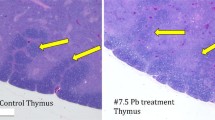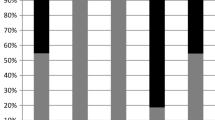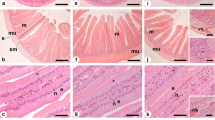Abstract
Ringed turtle doves ingested 0, 2, or 4 lead pellets and their blood was assayed for activity of the enzyme delta-aminolevulenic acid dehydratase (ALAD) at 24 hr and at sacrifice (14 days). At both blood sampling times, ALAD activity was reduced in the lead-treated birds concommitant with elevated blood lead concentrations. Hemoglobin concentration was not affected when assayed at sacrifice of the birds. Brain, liver, and kidney lead concentrations were significantly higher in doves that ingested lead shot. Approximately 70% of 110 mg lead pellets was eroded in the doves' gizzards in 14 days provided they were retained during that interval. Measurement of ALAD activity and blood lead offers potential for monitoring lead concentrations in wild mourning dove populations.
Similar content being viewed by others
References
Barthalmus, G. T., J. D. Leander, D. E. McMillan, P. Mushak, and M. T. Krigman: Chronic effects of lead on schedule controlled pigeon behavior. Toxicol. Applied Pharmacol.42, 271 (1977).
Bellrose, F. C.: Lead poisoning as a mortality factor in waterfowl populations. Illinois Nat. Hist. Survey Bull.27, 235 (1959).
Burch, H. B., and A. L. Siegel: Improved method for measurement of delta-aminolevulinic acid dehydratase activity of human erythrocytes. Clin. Chem.17, 1038 (1971).
Chisolm, J. J.: Lead poisoning. Sci. Am.224, 15 (1971).
Committee on Biologic Effects of Atmospheric Pollutants: Lead, airborne lead in perspective. Washington, DC: National Academy of Sciences (1972).
Cook, R. S., and D. O. Trainer: Experimental lead poisoning of Canada geese. J. Wildl. Manage.30, 1 (1966).
Delves, H. T.: A micro-sampling method for the rapid determination of lead in blood by atomic-absorption spectrophotometry. Analyst95, 431 (1970).
Dieter, M. P., M. C. Perry, and B. M. Mulhern: Lead and PCBs in canvasback ducks: Relationship between enzyme levels and residues in blood. Arch Environ. Contam. Toxicol.5, 1 (1976).
Kendall, R. J.: The toxicology of lead shot and environmental lead ingestion in avian species with emphasis on the biological significance in mourning dove populations. Ph.D. Dissertation. Virginia Polytechnic Institute and State University, Blacksburg (1980).
Kendall, R. J., and P. F. Scanlon: Lead concentrations in mourning doves collected from middle Atlantic game management areas. Proc. Southeastern Assoc. Fish Wildl. Agencies33, 165 (1979).
Lewis, J. C., and E. Legler, Jr.: Lead shot ingestion by mourning doves, J. Wildl. Manage.32, 476 (1968).
Locke, L. N., and G. E. Bagley: Lead poisoning in a sample of Maryland mourning doves. J. Wildl. Manage31, 515 (1967).
Longcore, J. R., L. N. Locke, G. E. Bagley, and R. Andrews: Significance of lead residues in mallard tissues. U.S. Fish and Wildl. Serv., Spec. Sci. Rep. Wildl. No. 182 (1974).
McConnell, C. A.: Experimental lead poisoning of bobwhite quail and mourning doves. Proc. Southeastern Assoc. Game and Fish Commissioners.21, 209 (1967).
Morgan, G. W., F. W. Edens, P. Thaxton, and C. R. Parkhurst: Toxicity of dietary lead in Japanese quail. Poultry Sci.54, 1636 (1975).
Morrison, D. F.: Multivariate statistical methods. 2 ed. New York: McGraw Hill (1976).
Ohi, G., H. Seki, K. Akiyama, and H. Yagyu: The pigeon, a sensor of lead pollution. Bull. Environ. Contam. Toxicol.12, 92 (1974).
Roscoe, D. E.: Pathology of plumbism in waterfowl and development of a simple diagnostic blood test. Ph.D. dissertation, Univ. Connecticut, Starrs (1978).
Scanlon, P. F., V. D. Stotts, R. G. Oderwald, T. J. Dietrick, and R. J. Kendall: Lead concentrations in livers of Maryland waterfowl with and without ingested lead shot present in gizzards. Bull. Environ. Contam. Toxicol,25, 855 (1980).
Steel, R. G. D., and J. H. Torrie: Principles and procedures in statistics. New York: McGraw Hill (1960).
Stone, C. L., K. R. Mahaffey, and M. R. S. Fox: A rapid bioassay system for lead using young Japanese quail. J. Environ. Pathol. Toxicol.2, 767 (1979).
Sturkie, P. D.: Secretion of gastric and pancreatic juice, pH, or tract, digestion in alimentary canal, liver, bile, and absorption. In P. D. Sturkie (ed): Avian Physiology. 3 ed. New York: Springer-Verlag (1976).
Westemeier, R. L.: Apparent lead poisoning in a wild bob-white. Wilson Bull.78, 471 (1966).
Author information
Authors and Affiliations
Rights and permissions
About this article
Cite this article
Kendall, R.J., Scanlon, P.F. & Di Giulio, R.T. Toxicology of ingested lead shot in ringed turtle doves. Arch. Environ. Contam. Toxicol. 11, 259–263 (1982). https://doi.org/10.1007/BF01055200
Received:
Accepted:
Issue Date:
DOI: https://doi.org/10.1007/BF01055200




